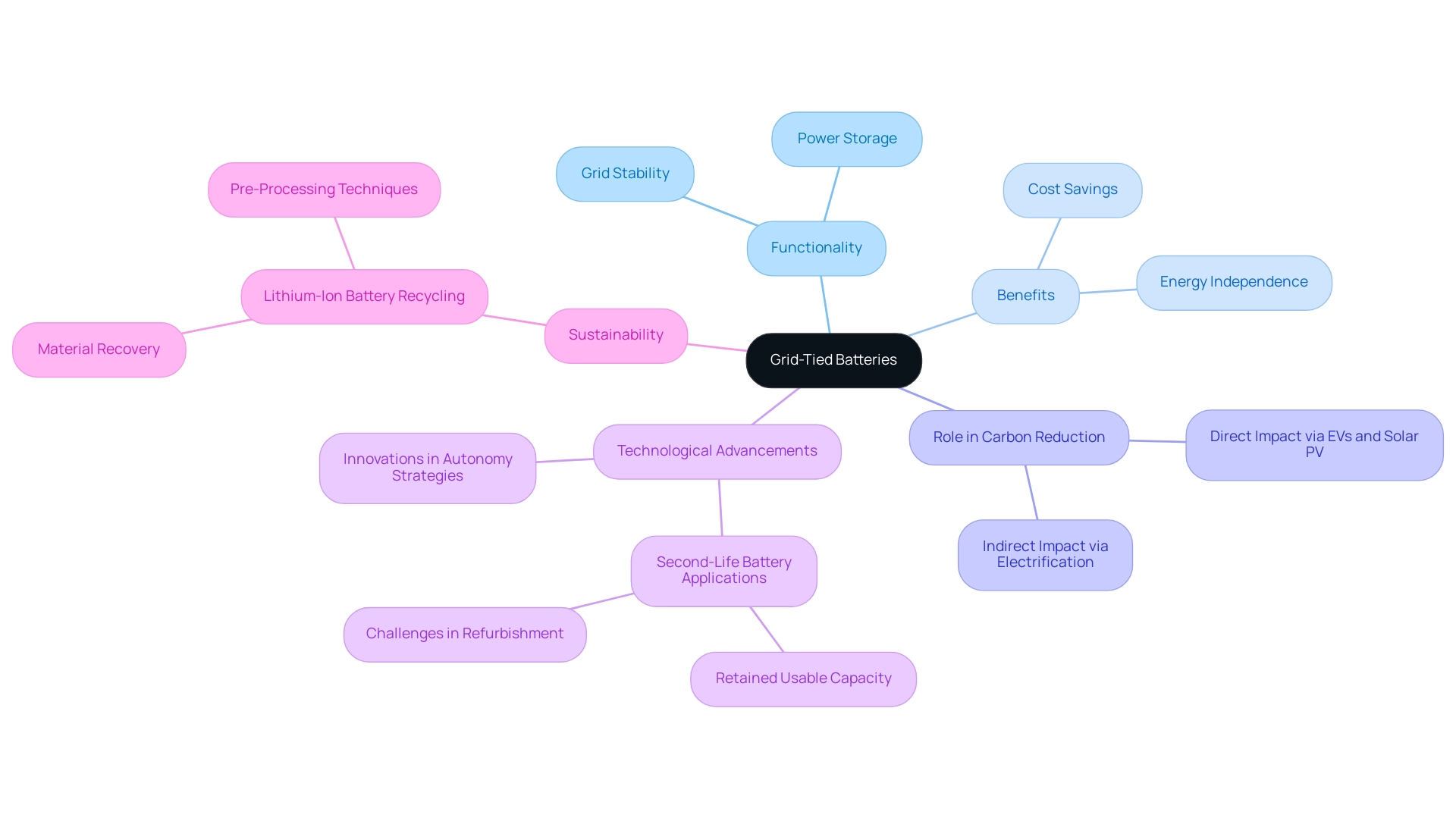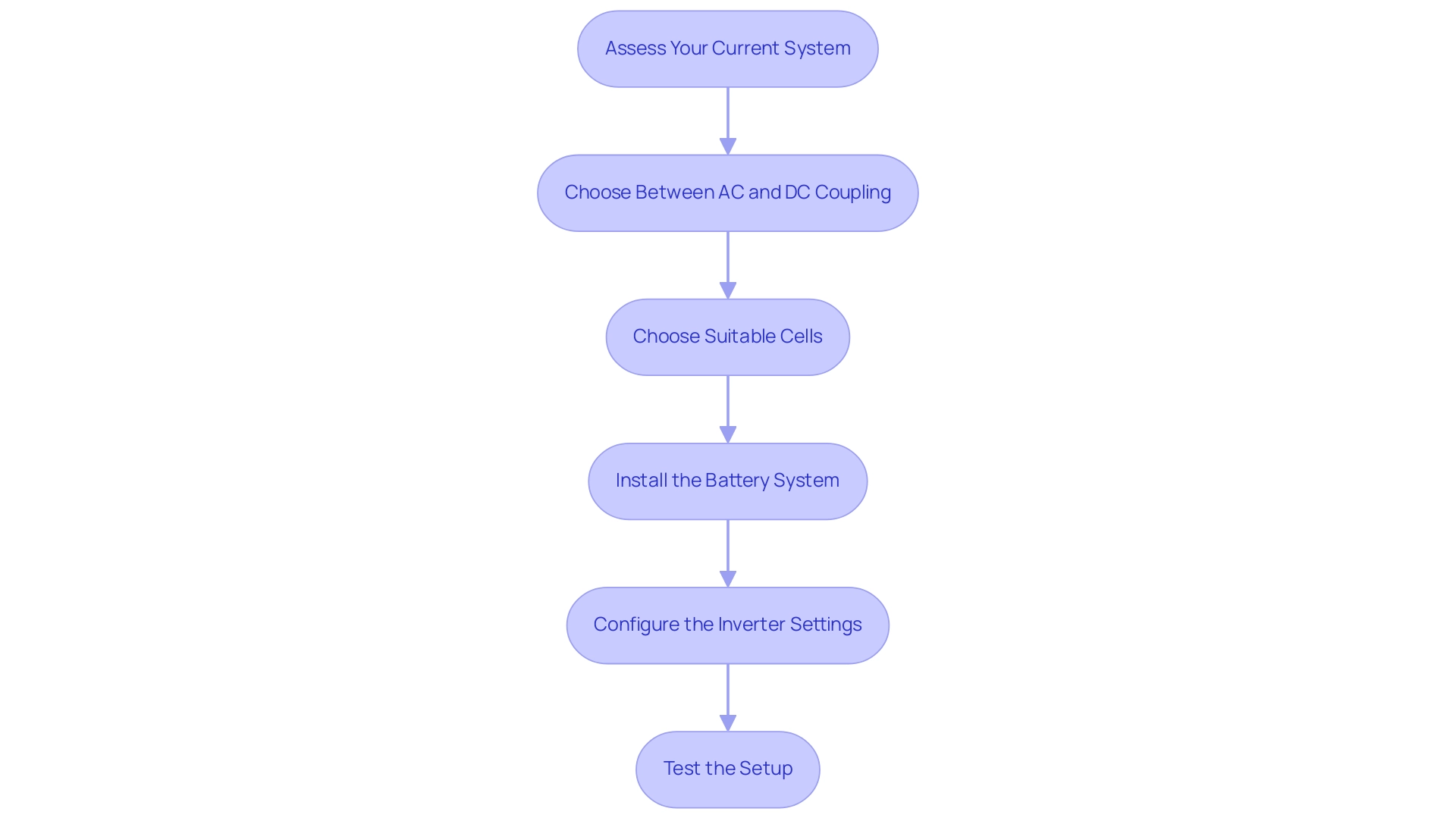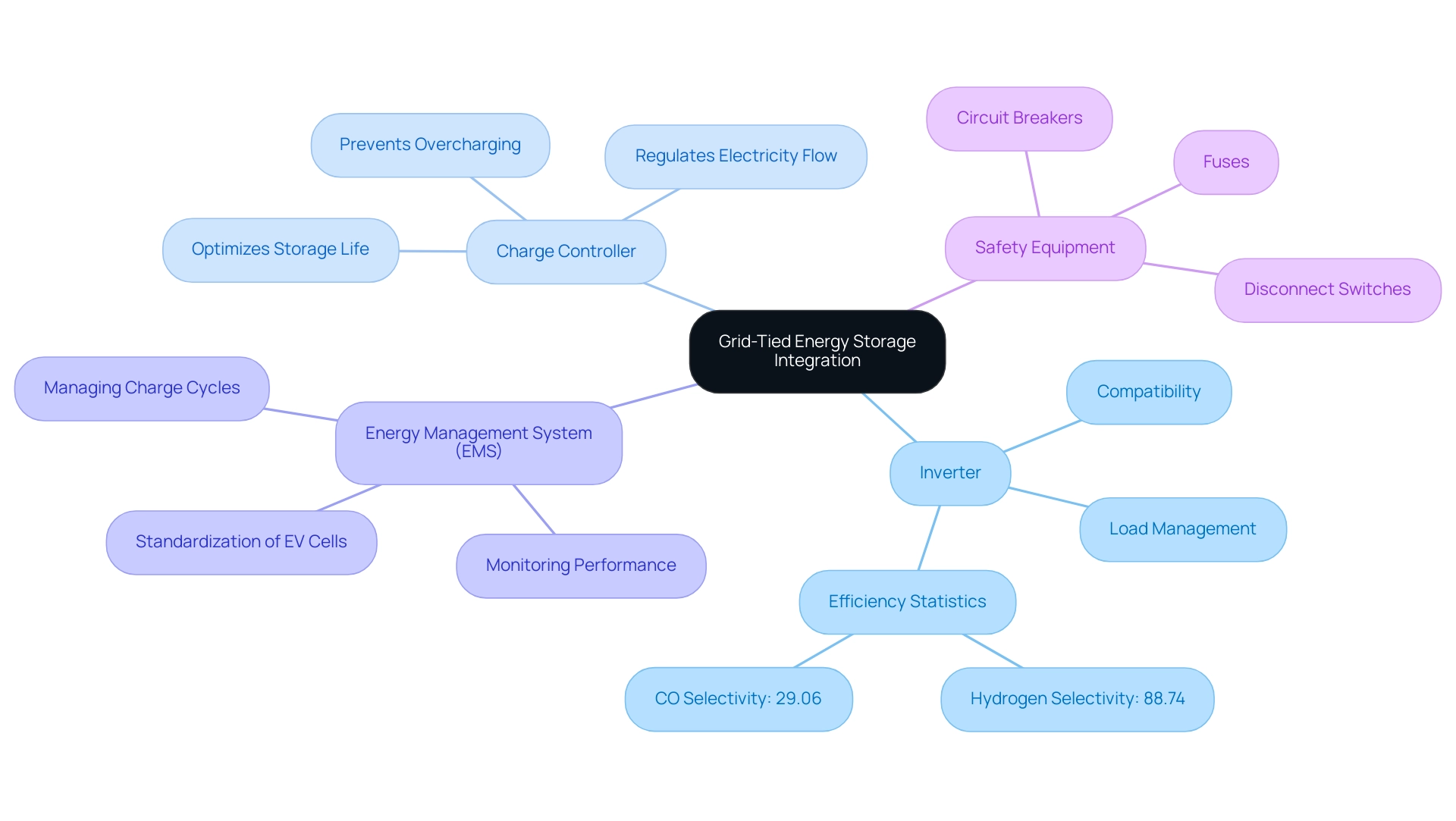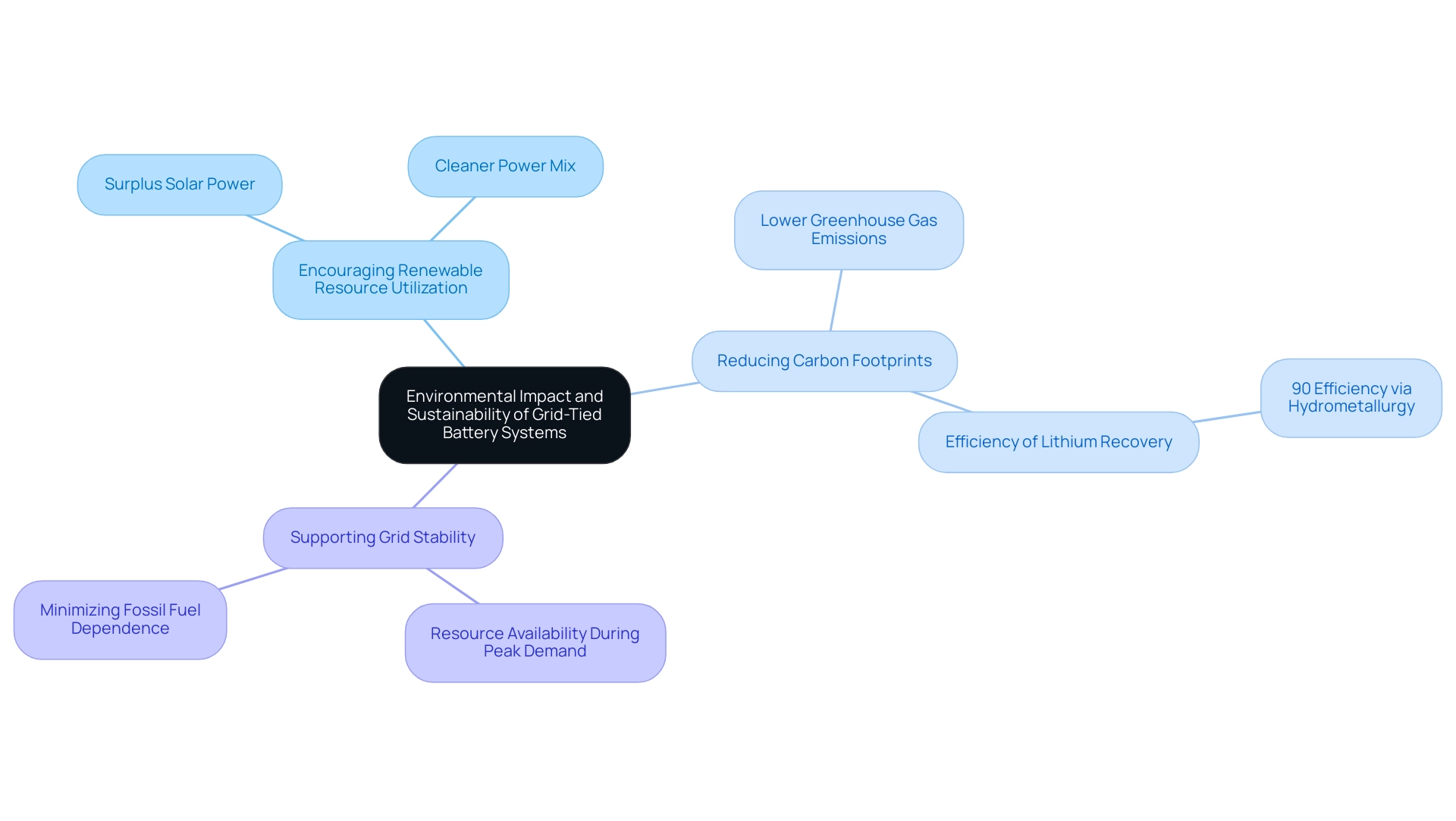Overview
The article focuses on the step-by-step process of integrating grid-tied batteries into solar energy systems, emphasizing the benefits of enhanced power independence and sustainability. It outlines crucial steps such as assessing existing systems, choosing between AC and DC coupling, and selecting suitable components, while also highlighting the significant environmental impact and cost savings associated with this technology, thereby supporting a more reliable and renewable energy future.
Introduction
The integration of grid-tied batteries into energy systems represents a significant advancement in the pursuit of sustainable power solutions. These systems not only enhance the efficiency of solar panel installations by storing excess energy generated during peak sunlight hours but also provide a reliable source of power during periods of low production or high demand.
As the world increasingly shifts towards renewable energy sources, grid-tied batteries emerge as essential tools in reducing dependence on fossil fuels and minimizing energy costs.
This article delves into the fundamentals of grid-tied batteries, their integration processes, key components, cost implications, and the broader environmental impacts, illustrating their crucial role in fostering a sustainable energy future.
Understanding Grid-Tied Batteries: Basics and Benefits
Grid-tied units function as sophisticated storage solutions that enhance solar panel systems by retaining surplus power produced during peak sunlight periods. This stored power can be utilized during periods of low solar production or during peak demand, thereby ensuring a more consistent and reliable power supply. The advantages of grid-tied battery integration include enhanced power independence and a diminished reliance on conventional power grids, which can lead to significant cost savings on bills.
Moreover, as the International Energy Agency (IEA) highlights, batteries could represent 60% of carbon reductions by 2030, both directly through EVs and solar PV installations and indirectly via electrification and renewable resource integration. This emphasizes the crucial role these systems have in promoting grid stability and aiding the shift towards renewable power sources. By 2035, oil displacement is anticipated to reach 11 mb/d in the STEPS and 12 mb/d in the APS, highlighting the need for efficient storage solutions such as grid-connected accumulators in decreasing fossil fuel reliance.
Additionally, lithium-ion cell recycling involves pre-processing and material recovery to reclaim valuable materials, emphasizing the sustainability aspect of these technologies. As we approach 2024, advancements in grid-tied battery integration technology continue to develop, promising higher adoption rates and further innovations in autonomy strategies. For instance, the emerging trend of second-life energy storage applications showcases the potential of repurposing retired electric vehicle power sources, which can retain up to 80% of their usable capacity.
Preliminary trials suggest encouraging results, although challenges persist concerning refurbishment expenses and competition with new storage systems, as emphasized in the case study context. Overall, the benefits of grid-tied battery integration extend beyond individual energy savings, contributing to the broader goal of a sustainable energy future.

Step-by-Step Integration Process: AC vs. DC Coupling
-
Assess Your Current System: Start by evaluating your existing solar setup to determine its compatibility with grid-tied battery integration. It’s essential to verify the inverter type, ensuring it accommodates energy storage units to facilitate a smooth transition.
-
Choose Between AC and DC Coupling:
- AC Coupling: This method connects batteries to the AC side of the inverter, offering greater flexibility for integration with existing systems. It is often simpler to implement, making it a popular choice for many installations. The self-consumption ratio for AC coupling is 70.15%, indicating its efficiency in energy utilization.
- DC Coupling: In this configuration, batteries are directly connected to the DC side of the solar panels. While this can enhance efficiency, as indicated by a self-consumption ratio of 68.38%, it may necessitate more intricate setups due to the complex interactions involved.
-
Choose Suitable Cells: Opt for cells that match your power needs. Consider factors such as capacity, discharge rates, and warranty terms to ensure long-term viability.
-
Install the Battery System: Adhere to the manufacturer’s installation guidelines, ensuring that all safety protocols are strictly followed to minimize risks during setup.
-
Configure the Inverter Settings: Adjust the inverter settings to recognize the newly installed energy storage. This step is crucial for optimizing performance and ensuring seamless operation through grid-tied battery integration. As highlighted by Yinghao Shan, this process includes an innovative model predictive power control (MPPC) scheme that synchronizes the dc-dc converter and inverter for optimal performance in grid-tied battery integration with PV setups and storage solutions.
-
Test the Setup: After installation, conduct thorough tests to verify that the energy storage unit operates correctly and integrates efficiently with your solar arrangement. Power flows under various irradiance conditions will illustrate the effectiveness of your configuration, confirming the cyclic operation of the energy storage system, which is essential for maintaining performance during energy demand fluctuations. Comprehending these power flows can aid in evaluating how effectively the network operates under varying conditions.

Key Components and Technical Considerations for Integration
When integrating grid-tied energy storage units, several key components must be carefully considered to ensure a successful implementation:
- Inverter: It is essential to select an inverter that is compatible with energy storage solutions. The inverter should be capable of managing the additional load during peak power production and consumption periods, ensuring efficient conversion and distribution. The recent statistic of 88.74% hydrogen selectivity and 29.06% CO selectivity emphasizes the significance of efficiency in energy storage setups, which is essential for optimizing energy storage solutions.
- Charge Controller: This component plays a vital role in regulating the flow of electricity between solar panels, energy reserves, and the grid. A well-designed charge controller is crucial for grid-tied battery integration as it prevents overcharging, thereby optimizing energy storage life and enhancing overall efficiency.
- Energy Management System (EMS): A robust EMS is crucial for monitoring energy storage performance. It protects the cells by ensuring safe operation, managing charge cycles, and maximizing lifespan through precise monitoring and control of cell conditions. The standardization and certification of utilized EV cells are essential for their efficient reuse, highlighting the necessity for clear guidelines in energy storage management approaches.
- Safety Equipment: Establishing safety measures is crucial to safeguard the framework from faults and overloads. This comprises circuit breakers, fuses, and disconnect switches, which act as vital protections against electrical failures.
Technical aspects involved in grid-tied battery integration include assessing the overall capacity to match demand, comprehending the discharge rates of the chosen cells, and ensuring adherence to local regulations governing power conservation mechanisms. A thorough evaluation of these factors not only enhances reliability but also contributes to its long-term sustainability. For instance, the case study on repurposing used electric vehicle power sources illustrates how retired units can provide substantial energy storage capacity for grid-scale applications, showcasing practical applications of these integrations.
This corresponds with recent progress in energy management technologies that emphasize efficiency and safety.

Cost Implications and Financial Benefits of Battery Integration
Integrating grid-tied energy storage systems presents a range of costs that stakeholders must consider:
- Initial Investment: This encompasses the expenses associated with purchasing energy storage units, inverters, installation services, and any necessary supplementary components. The 2024 Annual Technology Baseline (ATB) estimates a round-trip efficiency of 85%, influencing the overall cost analysis. Additionally, the Advanced Technology Innovation Scenario utilizes the lowest cost projections for 2022 to 2050, offering insights into potential future savings.
- Maintenance Costs: To guarantee optimal performance, regular maintenance is crucial. This may involve periodic inspections and potential replacements, which are essential to maintain efficiency.
Despite these costs, the financial advantages can be significant:
- Reduced Utility Bills: By harnessing and utilizing stored solar power, both homeowners and businesses can decrease their dependency on grid electricity, resulting in noteworthy savings on utility bills.
- Incentives and Rebates: Numerous regions provide financial incentives for solar and power installations, effectively alleviating some of the initial investment burden and enhancing the overall appeal of integrating these solutions.
- Increased Property Value: Properties equipped with renewable power capabilities often experience a boost in market value, attributed to improved efficiency and sustainability attributes.
In summary, the return on investment for grid-tied battery integration can be quite favorable, particularly in areas characterized by elevated electricity costs or where various incentives are readily available. As financial specialists recommend, utilizing these frameworks not only helps in attaining savings but also places properties favorably in an increasingly environmentally aware market. Moreover, as the industry progresses, repurposing utilized electric vehicle cells presents both challenges and opportunities for grid-scale power storage, emphasizing the continuous innovations in this sector.
As late-career professionals are encouraged to leverage their experience, negotiating optimal vendor contract lengths can also contribute to long-term stability and adaptability in this rapidly changing landscape.
Environmental Impact and Sustainability of Grid-Tied Battery Systems
Grid-connected storage solutions are crucial in improving sustainability in several aspects:
- Encouraging Renewable Resource Utilization: These setups efficiently retain surplus solar power, enabling the greater use of renewable assets. This ability is essential in diminishing dependence on fossil fuels, as it permits a smooth shift between power generation and usage, ultimately resulting in a cleaner power mix.
- Reducing Carbon Footprints: The incorporation of storage units contributes significantly to lowering greenhouse gas emissions associated with power generation. As these systems capture and store power generated from renewable sources, they play a vital role in mitigating climate change. Studies indicate that the adoption of grid-tied energy storage technologies is associated with a notable reduction in carbon footprints, aligning with contemporary sustainability goals. Significantly, lithium obtained through hydrometallurgy has a 90% efficiency, highlighting the sustainability and effectiveness of these power systems.
- Supporting Grid Stability: During peak demand periods, grid-tied storage solutions provide crucial stored resources, assisting in maintaining grid stability. This capability not only minimizes the need for additional fossil fuel-based power generation but also enhances the overall resilience of the power grid. By easing pressure during peak demand, these frameworks contribute to a more dependable and sustainable power infrastructure.
In light of recent analysis, the future of lithium-ion cell production appears promising, with projections suggesting a potential reduction in greenhouse gas intensity by up to 50% by 2050, contingent on the decarbonization of the electricity sector and the adoption of innovative cell chemistries. As stated by J.A.L.-O. and co-authors, tackling the challenges of repackaging and standardization of utilized electric vehicle energy sources is critical.
Unlocking significant value for grid-scale power storage could further enhance the environmental benefits associated with grid-tied battery integration. This emphasis on reliable data regarding material and energy consumption is essential to accurately quantify the environmental impacts associated with different LIB technologies.

Conclusion
The integration of grid-tied batteries into energy systems marks a transformative step towards achieving a more sustainable energy landscape. These advanced energy storage solutions not only enhance the efficiency of solar panel installations but also provide a reliable power source during periods of low production or peak demand. The benefits of grid-tied batteries extend beyond individual energy savings, contributing significantly to energy independence, cost reductions, and a diminished reliance on fossil fuels.
A thorough understanding of the integration process, including key components such as:
- inverters
- charge controllers
- battery management systems
is essential for successful implementation. Careful consideration of technical factors, alongside an analysis of cost implications and financial benefits, highlights the potential for substantial returns on investment. Furthermore, the environmental impact of these systems underscores their importance in promoting renewable energy usage and reducing carbon footprints.
As advancements in battery technology continue to evolve, the role of grid-tied batteries in fostering a sustainable energy future becomes increasingly clear. By harnessing the power of renewable resources and supporting grid stability, these systems not only provide immediate benefits but also pave the way for a cleaner, more resilient energy infrastructure. Embracing grid-tied battery technology is not merely an option—it is a crucial step towards a sustainable and energy-efficient future.
Frequently Asked Questions
What are grid-tied battery units?
Grid-tied battery units are storage solutions that enhance solar panel systems by storing surplus power produced during peak sunlight periods for later use during low solar production or peak demand, ensuring a consistent and reliable power supply.
What are the advantages of integrating batteries with grid-tied systems?
The advantages include enhanced power independence, reduced reliance on conventional power grids, and significant cost savings on energy bills.
How do batteries contribute to carbon reduction by 2030?
According to the International Energy Agency (IEA), batteries could account for 60% of carbon reductions by 2030 through their use in electric vehicles (EVs) and solar photovoltaic (PV) installations, as well as through electrification and renewable resource integration.
What is the anticipated impact of efficient storage solutions by 2035?
By 2035, oil displacement is expected to reach 11 million barrels per day (mb/d) in the STEPS scenario and 12 mb/d in the APS scenario, highlighting the need for efficient storage solutions like grid-connected accumulators to decrease reliance on fossil fuels.
What role does lithium-ion cell recycling play in sustainability?
Lithium-ion cell recycling involves pre-processing and material recovery to reclaim valuable materials, which emphasizes the sustainability aspect of battery technologies.
What advancements are being made in grid-tied battery integration technology?
Advancements include higher adoption rates and innovations in autonomy strategies, such as second-life energy storage applications that repurpose retired EV power sources, retaining up to 80% of their usable capacity.
What challenges are associated with second-life energy storage applications?
Challenges include refurbishment expenses and competition with new storage systems, which can impact the viability of repurposing retired batteries.
What steps should be taken to integrate grid-tied batteries with existing solar systems?
The steps include assessing the current system, choosing between AC and DC coupling, selecting suitable battery cells, installing the battery system, configuring the inverter settings, and testing the setup to ensure proper operation.
What is the difference between AC and DC coupling in battery integration?
AC coupling connects batteries to the AC side of the inverter, offering flexibility and a self-consumption ratio of 70.15%. DC coupling connects batteries directly to the DC side of solar panels, enhancing efficiency with a self-consumption ratio of 68.38%, but may require a more complex setup.
Why is testing the battery setup important after installation?
Testing is crucial to verify that the energy storage unit operates correctly and integrates efficiently with the solar arrangement, ensuring optimal performance during energy demand fluctuations.




